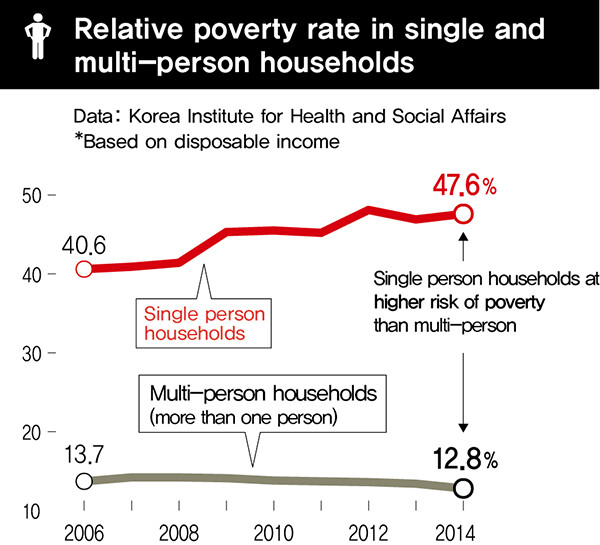hankyoreh
Links to other country sites 다른 나라 사이트 링크
Middle aged people are fasting growing portion of increase in single-person households

Han Cheol-su (not his real name, 50) lives by himself in a government-subsidized apartment in Seoul. He has been living alone for 10 years since getting divorced in 2006.
Before getting divorced, he opened a raw fish restaurant after taking out a mortgage on his home and getting some help from his wife’s family, but business was poor. Eventually, he had to close, and relations soured with his wife, leading to divorce.
All three of Han’s children live with their mother, and Han works on construction sites as a day laborer. Some months, when he can’t get much work or his health is poor, his earnings dip below 500,000 won (US$458). “The worst part about it is that I can’t afford to help my kids even though I want to,” he said.
With the number of people living alone on the rise across every age group, single-person households have emerged as the most common household type in South Korea. There are concerns that single-person households are likely to become a new vulnerable sector in the areas of income, residence and health. The poverty rate in single-person households is four times higher than in multi-person households.
According to Hankyoreh analysis of the findings of population and housing surveys carried out by Statistics Korea over the past two decades, the number of single-person households increased from 1.64 million in 1995 to 5.20 million last year, a jump from 12.7% to 27.2% of all households. Four-person households - the traditional household in which parents and children live together - were the most common household type as recently as 2005, but in 2010 they gave way to two-person households. Last year, single-person households rose to first place.
Amid the sharp increase in single-person households, the percentage of poor single-person households is growing quickly as well. According to the “2015 Yearly Report on Poverty Statistics” put out by the Korea Institute for Health and Social Affairs (KIHASA), the relative poverty rate for single-person households (households whose income is less than 50% of the median income) rose from 40.6% in 2006 to 47.6% in 2014. During the same period, the relative poverty rate for all households excluding single-person households decreased from 13.7% to 12.8%. This shows that people living by themselves are at a higher risk of poverty.
Experts are drawing particular attention to the fact that there are not only more young and elderly people living alone but also more middle-aged people like Han. A significant number of them are not only exposed to poverty right now but are also very likely to join the elderly poor, since they cannot afford to set aside money for their retirement.
When single-person households are analyzed by age group, the largest percentage as of last year were those 60 and older (30.3%), followed by people in their thirties (18.3%). Middle-aged people (in their forties and fifties) accounted for 16.3% and 16.9% of the group, respectively, representing 33.2% of all single-person households. Twenty years ago, middle-aged individuals only accounted for 21.1% of single-person households.
By Hwangbo Yon, staff reporter
Please direct questions or comments to [english@hani.co.kr]

Editorial・opinion
![[Column] Has Korea, too, crossed the Rubicon on China? [Column] Has Korea, too, crossed the Rubicon on China?](https://flexible.img.hani.co.kr/flexible/normal/500/300/imgdb/original/2024/0419/9317135153409185.jpg) [Column] Has Korea, too, crossed the Rubicon on China?
[Column] Has Korea, too, crossed the Rubicon on China?![[Correspondent’s column] In Japan’s alliance with US, echoes of its past alliances with UK [Correspondent’s column] In Japan’s alliance with US, echoes of its past alliances with UK](https://flexible.img.hani.co.kr/flexible/normal/500/300/imgdb/original/2024/0419/2317135166563519.jpg) [Correspondent’s column] In Japan’s alliance with US, echoes of its past alliances with UK
[Correspondent’s column] In Japan’s alliance with US, echoes of its past alliances with UK- [Editorial] Does Yoon think the Korean public is wrong?
- [Editorial] As it bolsters its alliance with US, Japan must be accountable for past
- [Guest essay] Amending the Constitution is Yoon’s key to leaving office in public’s good graces
- [Editorial] 10 years on, lessons of Sewol tragedy must never be forgotten
- [Column] A death blow to Korea’s prosecutor politics
- [Correspondent’s column] The US and the end of Japanese pacifism
- [Guest essay] How Korea turned its trainee doctors into monsters
- [Guest essay] As someone who helped forge Seoul-Moscow ties, their status today troubles me
Most viewed articles
- 1[Column] The clock is ticking for Korea’s first lady
- 2Hong Se-hwa, voice for tolerance whose memoir of exile touched a chord, dies at 76
- 3After 2 months of delayed, denied medical care, Koreans worry worst may be yet to come
- 4[Column] Has Korea, too, crossed the Rubicon on China?
- 5Samsung barricades office as unionized workers strike for better conditions
- 6US overtakes China as Korea’s top export market, prompting trade sanction jitters
- 7All eyes on Xiaomi after it pulls off EV that Apple couldn’t
- 8[Guest essay] How Korea turned its trainee doctors into monsters
- 9[Editorial] As it bolsters its alliance with US, Japan must be accountable for past
- 10[Correspondent’s column] In Japan’s alliance with US, echoes of its past alliances with UK